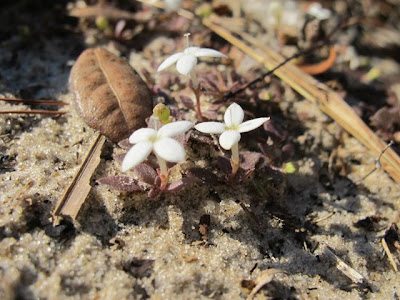Confession: As a Leo, beaches make me want to walk more than swim. I love to pace along the ocean’s edge, but I’m not the Amazon who rushes into the waves, peeling clothing as she goes, then dives like a porpoise into the sea’s watery embrace, bobbing up slick as a seal and laughing. Nuh-uh. The sea delights me visually and conceptually, but unless the water’s bathtub warm I’ll leave the frolicking to those who are better at it.
So while Phoebe and Liam dared the waves I walked. On a beach, I tend to pick a visual point, be it bird, carcass, pier, or fisherman, and walk toward it.

I noticed a small flurry of bird activity near an orange-clad fisherman, and made that my destination. Wheeling back occasionally to watch the kids through binoculars, I finally reached him and sat a respectful distance away photographing the gulls, grackles and shorebirds attracted to his station. He made a crack about being the birds’ agent and demanding I feed them before photographing them. With that little gesture, he set me at ease and let me know it was all right for me to share his space. I thought I detected a native Floridian in his easy demeanor and that hunch was confirmed. I really just wanted to find out what was happening between him, the sea and the birds. I figured there was food involved, and was intrigued by the assemblage of eight species he’d attracted: sanderling, ruddy turnstone, boat-tailed grackle; great black-backed, laughing, herring and ring-billed gull.
Soon enough, I noticed a couple of sand-covered
Florida pompano Trachinotus carolinus (Jack family, Carangidae)
breathing their last on the beach, and the little assemblage of avian undertakers suddenly made sense. The fisherman was winding up his day, and he took the fish down to the waves to wash them before processing them. Pompano is said to be delicious, commanding the highest price dockside of any fish. Sadly, I wouldn’t know, never having been in pompano country. I'm in farm-raised catfish country :-/
One pompano had departed this mortal coil, turning ghostly silver-white in the process. Still it was a gorgeous creature, with touches of yellow on tail and fins. I turned to the live one. It shimmered with blue, lavender and rose, the colors playing across its impossibly satiny, fine-grained skin.
I wondered what it was thinking as it glared at me, this huge hominid pointing a black box at it, and it made a mighty flex of body and tail as if in response. If you aren’t going to kill me, throw me back, idiot; I’m dying here.
It was a tricky moment for a compulsive helper of the helpless. I don’t know what the pompano knew at this sorry nadir in its short life; whether it perceived me as a possible savior or just another awful spectre in its dimming eye. What I’m sure it couldn’t appreciate is that I was a guest in this state; on this unmarked spot on the beach. It wasn’t my place to take dinner out from under the Florida native who so genially tolerated my presence.
I am sorry, so sorry. I can’t help you. I could throw you back and take off running down the beach, I suppose, but this man has been here all day waiting for you to take his lure, and you struck it, and this is what happens when you make the last and worst mistake a fish can make. Besides, whether I throw you back or not, you are done for, my silvery friend. You’ve been too long in the thin cold air.
You are never going back home to the waves.
I screwed my heart’s porthole closed again and kept shooting. While I’d been talking to the still-living fish, the fisherman had filleted the dead pompano.
The fisherman came and got the live fish and washed it in the surf. I pointed out the lavender, blue and rose still playing across its skin. I asked him if they always turn white when they die and he said he’d never noticed. He held it up to let me admire it for a moment before deploying his filet knife.
And with the first cut, he quickly turned a living being into food.
So this is how it's done.
First he cut the muscle off one side, then he flipped it over and cut the other.
He cut two smooth filets off its sides, leaving the head, spine, ribs and organs in place, taking all the muscle the fish had and leaving nothing, really, and I wondered as I watched with dry amazed eyes when in the process the fish finally died. He dropped the filets into a plastic bag and I felt a little envy because at that moment they looked like very nice food to me. We had been eating out in a bland, unimaginative sort of way for several days and the cook in me was yearning for something fresh to prepare. I asked him if the two small pompano would be tonight’s dinner, and he said no, if you came out here expecting to catch your dinner a lot of times you’d go hungry. He would put them in the freezer for later. For some reason that made me feel bad. I hoped his freezer wasn’t like mine: a place where meat lies in state until it’s fit for offering to the vultures.
And then he unceremoniously tossed what was left of the beautiful pompano to the birds.
I kept watching, of course...

































































Sunday, February 27, 2011
9 comments